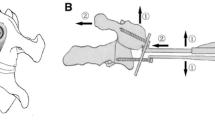Abstract
Purpose
Recently, it has been demonstrated that anterior release of tight structures via a transoral approach can assist posterior distraction–reduction technique in restoring the cranio-cervical anatomy in irreducible atlantoaxial dislocations. Our aim was to evaluate the radiological and clinical outcome of anterior release and posterior instrumentation for irreducible congenital basilar invagination.
Methods
A consecutive series of 15 patients (2007–2009) with irreducible congenital basilar invagination were treated with anterior release using transoral approach. A retrospective chart review was performed. All patients presented with myelopathy. Dislocation was treated as irreducible if acceptable reduction was not achieved with traction under general anesthesia and neuromuscular paralysis. The anterior release comprised of transverse sectioning the longus colli and capitis, C1–C2 joint capsular release and intra-articular adhesiolysis with or without anterior C1 arch excision. Cantilever mechanism using posterior instrumentation was used to correct any residual malalignment.
Results
Mean age was 21.4 (10–50) years. Average duration of follow-up was 28 (24–40) months. The average preoperative JOA score was 11.4 (8–16), which improved to 15.4 (10–18) after surgery. Anatomical reduction was achieved in thirteen patients. Fusion was documented in all patients. Complications included persistent nasal phonation in one, and superficial wound dehiscence in one.
Conclusion
We believe that a significant number of irreducible dislocations can be anatomically reduced with this procedure thus avoiding odontoid excision. Encouraging results from this short series have given us a new perspective in dealing with these challenging problems.





Similar content being viewed by others
Abbreviations
- CVJ:
-
Cranio vertebral junction
- JOA:
-
Japanese Orthopedic Association
- pBC2:
-
Distance of the odontoid tip from the line joining the basion and the posteroinferior corner of C2
References
Menezes AH, VanGilder JC, Graf CJ, McDonnell DE (1980) Craniocervical abnormalities. A comprehensive surgical approach. J Neurosurg 53:444–455. doi:10.3171/jns.1980.53.4.0444
Mouchaty H, Perrini P, Conti R, Di Lorenzo N (2009) Craniovertebral junction lesions: our experience with the transoral surgical approach. Eur Spine J 18:13–19. doi:10.1007/s00586-009-0988-7
Perrini P, Benedetto N, Guidi E, Di Lorenzo N (2009) Transoral approach and its superior extensions to the craniovertebral junction malformations: surgical strategies and results. Neurosurgery 64:331–342. doi:10.1227/01.NEU.0000334430.25626.DC (discussion 342)
Wang C, Yan M, Zhou HT et al (2006) Open reduction of irreducible atlantoaxial dislocation by transoral anterior atlantoaxial release and posterior internal fixation. Spine 31:E306–E313. doi:10.1097/01.brs.0000217686.80327.e4
Goel A (2004) Treatment of basilar invagination by atlantoaxial joint distraction and direct lateral mass fixation. J Neurosurg Spine 1:281–286. doi:10.3171/spi.2004.1.3.0281
Benzel EC, Lancon J, Kesterson L, Hadden T (1991) Cervical laminectomy and dentate ligament section for cervical spondylotic myelopathy. J Spinal Disord 4:286–295
Wang S, Wang C, Passias PG et al (2009) Interobserver and intraobserver reliability of the cervicomedullary angle in a normal adult population. Eur Spine J 18:1349–1354. doi:10.1007/s00586-009-1112-8
Grabb PA, Mapstone TB, Oakes WJ (1999) Ventral brain stem compression in pediatric and young adult patients with Chiari I malformations. Neurosurgery 44:520–527 (discussion 527–8)
Smoker WR (1994) Craniovertebral junction: normal anatomy, craniometry, and congenital anomalies. Radiographics 14:255–277
Tubbs RS, Lancaster JR, Mortazavi MM et al (2011) Morphometry of the outlet of the foramen magnum in crania with atlantooccipital fusion. J Neurosurg Spine 15:55–59. doi:10.3171/2011.3.SPINE10828
Goel A, Kulkarni AG, Sharma P (2005) Reduction of fixed atlantoaxial dislocation in 24 cases: technical note. J Neurosurg Spine 2:505–509. doi:10.3171/spi.2005.2.4.0505
Jian F-Z, Chen Z, Wrede KH et al (2010) Direct posterior reduction and fixation for the treatment of basilar invagination with atlantoaxial dislocation. Neurosurgery 66:678–687. doi:10.1227/01.NEU.0000367632.45384.5A (discussion 687)
Hsu W, Zaidi HA, Suk I et al (2010) A new technique for intraoperative reduction of occipitocervical instability. Neurosurgery 66:ons319–ons324. doi:10.1227/01.NEU.0000369925.81522.60
Yoshizumi T, Murata H, Ikenishi Y et al (2014) Occipitocervical fusion with relief of odontoid invagination: atlantoaxial distraction method using cylindrical titanium cage for basilar invagination—case report. Neurosurg Rev. doi:10.1007/s10143-014-0531-0
Smith JS, Shaffrey C, Abel MF, Menezes AH (2010) Basilar invagination. Neurosurgery 66:39–47. doi:10.1227/01.NEU.0000365770.10690.6F
Wang S, Wang C (2010) Response to the expert’s comment of P. Suchomel concerning grand rounds case entitled “Syringomyelia with irreducible atlantoaxial dislocation, basilar invagination and Chiari I malformation”, Eur Spine J, 19(3), 2010, pp. 367–369 (by Shenglin Wang et al.). Eur Spine J. doi:10.1007/s00586-010-1397-7
Suchomel P (2010) Expert’s comment concerning Grand Rounds case entitled “Syringomyelia with irreducible atlantoaxial dislocation, basilar invagination and Chiari I malformation” (by Shenglin Wang, Chao Wang, Ming Yan, Haitao Zhou, Liang Jiang). Eur Spine J 19:367–369. doi:10.1007/s00586-009-1209-0
Conflict of interest
No funds were received in support of this work. No benefits in any form have been or will be received from a commercial party related directly or indirectly to the subject of this manuscript. Approval by the authors’ institutional review board (IRB) was obtained.
Author information
Authors and Affiliations
Corresponding author
Rights and permissions
About this article
Cite this article
Laheri, V., Chaudhary, K., Rathod, A. et al. Anterior transoral atlantoaxial release and posterior instrumented fusion for irreducible congenital basilar invagination. Eur Spine J 24, 2977–2985 (2015). https://doi.org/10.1007/s00586-015-3836-y
Received:
Revised:
Accepted:
Published:
Issue Date:
DOI: https://doi.org/10.1007/s00586-015-3836-y




